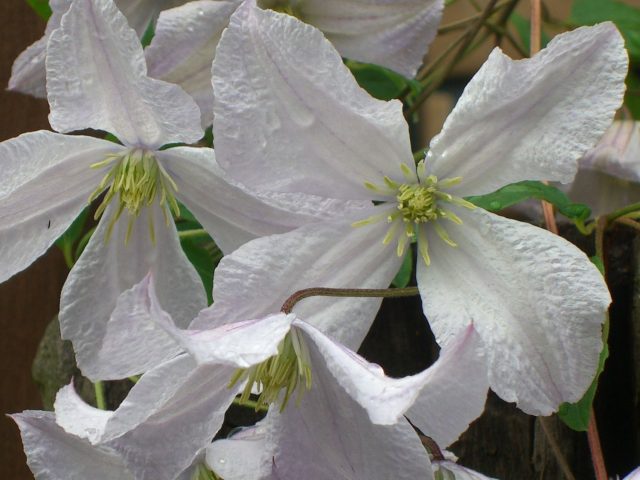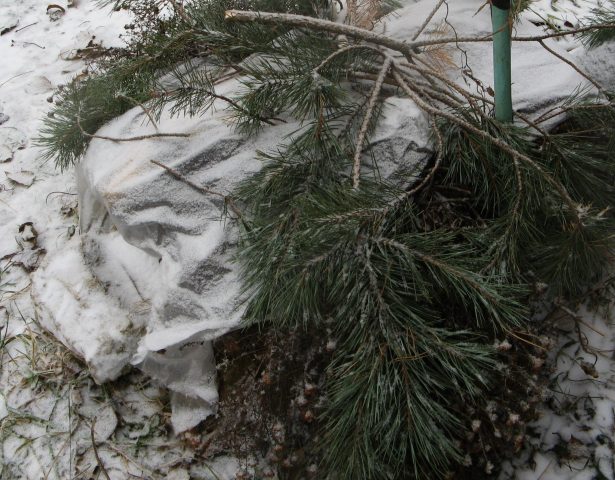Content
Prince Charles White Clematis is a compact cultivar native to Japan with abundant flowering. The shrub is used to decorate gazebos, fences and other garden structures; you can also plant the plant as a ground cover crop.
Description of Clematis Prince Charles
The height of the shrub can reach 2-2.5 m, the flowers are medium in size, their average diameter is 6-7 cm. In their appearance, they resemble six-pointed (sometimes four-pointed) white stars with a yellowish core. The petals of Prince Charles clematis are oval, strongly pointed at the end, and the very tip curls downward, as can be seen in the photo below. The edges of the petals often appear frayed.
On the outside, the flowers of this variety are painted in light pink tones, darkening at the base and smoothly turning into a delicate purple hue. In the middle of the petal, there is sometimes a pronounced vein of dark pink color. The leaves of the shrub are mostly solitary, dull, smooth to the touch.
The Prince Charles variety blooms in June-July, the flowering is very abundant. The shrub blooms again in August. As it grows, the plant clings to artificial or natural support with leaf petioles.
Conditions for growing clematis varieties Prince Charles
Clematis cannot be called a capricious culture, however, there are still a number of conditions necessary for the full development of a shrub. It is recommended to adhere to the following recommendations when growing a Prince Charles crop:
- Clematis is best planted in partial shade or in the sun. Strong shading inhibits the growth of the shrub, its flowering becomes less abundant.
- Preferred type of soil: loose sandy loam or loamy soils, rich in humus. The acidity of the planting site should not be high.
- Clematis is a moisture-loving culture. He does not tolerate drying out of the soil, so the bush is often watered. For better moisture retention, herbaceous crops are planted under it: marigolds, phloxes, lavender. They shade the lower part of the plant, which slows down the evaporation of moisture. Also, the Prince Charles variety responds well to mulching the trunk circle. To do this, you can use chopped pine bark, wood chips, turf, peat, spruce branches or moss.
- Despite its moisture-loving nature, this shrub does not tolerate stagnation of water in the soil. In order to avoid decay of the roots of clematis, it is planted in an area with a low level of groundwater occurrence - they must pass at a depth of at least 1 m.If they go higher, clematis is planted on a bulk hill.
Planting and caring for white clematis Prince Charles
Sowing seeds for seedlings is carried out from December to March. Clematis seedlings are planted in open ground either in spring or autumn. Before planting, it is necessary to prepare the soil in advance: the selected area is dug up and humus is introduced into the soil.
The planting algorithm for the Prince Charles variety is as follows:
- In the prepared area, a hole is dug about 60-70 cm deep and 60 cm wide.
- A support is installed in the center of the pit, after which a drainage layer of broken brick or crushed stone is laid out on the bottom.
- A soil mixture of the following composition is poured onto the drainage from above: the upper fertile soil layer dug out of the pit, 2 buckets of humus, 1 bucket of peat, 1 bucket of sand, 100 g of bone meal and 200 g of ash. Fill the hole to the middle, forming a mound.
- The roots of clematis are spread on the resulting earthen hill. They are sprinkled with earth so that the seedling is buried 8-12 cm.
- The planting is completed with abundant watering and mulching of the trunk circle with peat.
If clematis is planted in the spring, then the planting hole is not covered with soil mixture to the end - it is necessary to leave about 5-7 cm from the surface of the earth. The resulting hole is filled as the shoots become lignified. When planting in the autumn months, the pit is completely filled up and even a little with a slide.
Prince Charles is fed clematis according to the following scheme:
- during the period of active growth - nitrogen fertilizers;
- during the formation of buds - potash;
- after flowering - phosphoric;
- during flowering, clematis do not feed.
Green fertilizers, mullein infusion and horse manure solution are well suited for the growth of vines. In the summer months, clematis respond well to complex mineral fertilizers, a weak solution of boric acid and potassium permanganate. In August, it is useful to feed the shrub with a superphosphate solution - this way you can prolong its flowering. Nitrogen fertilizers should no longer be applied in August.
The bush is watered once a week, the optimal amount of water is 20-25 liters for each bush. In hot weather, the interval between watering is reduced to 5 days. When heavy rains begin, you do not need to water the clematis.
Preparing for winter
In the south of the country, clematis can not be covered, however, in the middle zone and in the north of Russia, the Prince Charles variety must be insulated for the winter.
The bushes are covered with the onset of -5-7 ° C, when the soil begins to freeze. In central Russia, this temperature is set in November. Cut clematis are sprinkled with dry earth so that a hill about 50 cm high (about 3-4 buckets of earth) forms above the plant. In winter, this hill will be covered with snow, as a result of which natural insulation of the bush is formed, which will protect it from freezing. Additionally, you can overlay an earthen mound with spruce branches if there are severe frosts in the growing region in winter.
In the spring, the shelter is not removed immediately, but gradually.
Reproduction
According to the description of the Prince Charles variety, clematis can be propagated in almost all available ways:
- cuttings;
- dividing the bush;
- through the seeds;
- layering;
- vaccination.
The most troublesome is the seed method of reproduction, it takes a lot of time and effort. Moreover, when grown independently from seeds, clematis may lose its varietal qualities.
Most often, the Prince Charles variety is propagated by cuttings or layering. In the second case, the planting material is harvested as follows:
- In autumn, clematis is cut to the first bud.
- All cut shoots with a developed bud are removed into a depression with peat, sprinkled with fertile soil and covered with spruce branches. In this form, the segments hibernate.
- In the spring, the dug shoots are watered. When the first shoots appear, the site is mulched with peat.
- By autumn, seedlings form quite strong shoots. They can now be dug up to be placed in a permanent location.
Diseases and pests
The Prince Charles variety is resistant to viral diseases, however, the plant can infect the fungus.Powdery mildew and rust pose the greatest threat to shrubs. The bushes are treated with a solution of "Fundazol", dry powder "Trichodermina" or 2% solution of "Azocel".
If clematis gets sick with leaf spot, the plant is sprayed with Bordeaux liquid or 1% copper sulfate solution.
Conclusion
Clematis Prince Charles is a rather unpretentious and hardy plant, which allows it to be grown in almost all regions of Russia. It easily tolerates low temperatures and develops well on almost all types of soil. In landscape design, shrubs are used primarily to decorate gazebos, arched structures, verandas and fences; you can also create a hedge from clematis.
You can learn more about the features of clematis from the video below:
Reviews of Clematis Prince Charles
The only thing that darkens the impression is that I did not know that it is not recommended to transplant clematis. Then I learned from a neighbor that it was necessary to approach the choice of a site more responsibly, a bush has been growing in one place for many years. I planted it temporarily on a vacant site, then planned to transplant. Now I don't want to risk it, a very beautiful bush has grown.










